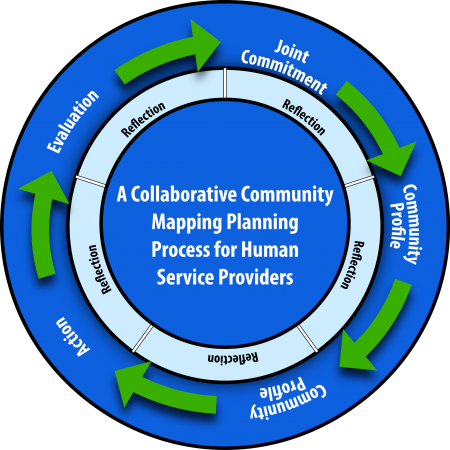M.A.P.S. is committed to a community development approach which views each group of partners as unique. It is recognized that the community mapping process is achieved in a time frame as determined by the members of the partnership.
M.A.P.S. has identified five phases of community mapping. They are:
-
Joint Commitment: members agree on a common purpose; boundaries are defined and agreement is reached on what the group wishes to accomplish together
-
Creating Community Profile: information is gathered about the community; the information is mapped and; the maps are supplemented with narratives
-
Community Engagement: others are invited to review the community profile created; as agreed, the profile is revised and/or enhanced; community needs, strengths, gaps and resources are identified and; an action plan is created
-
Action: the action plan is implemented
-
Evaluation: successes and challenges in working together are identified and documented; successes and challenges in achieving expected outcomes are identified and documented. And the cycle starts again with a discussion regarding ongoing joint commitment to planning together

Community Mapping & Planning: An evolving process with human service providers to assist with collaborative planning.
Question
Method
Purpose
Expected Outcomes
What is the make up of our community?
Map Demographics
- Age
- Income
- Education
- Cultural identity
- Community vulnerability
To provide information to human service colleagues regarding the community they serve.
Human service providers meet the needs of a community more effectively.
What supports and services exist in our community?
Map Resources/Assets
- Associations
- Volunteer Programs
- Funded programs/agencies
- Neighbourhood based programs
- and more.
To provide information to human service providers about existing supports and services.
Gaps and overlaps in services will be identified. Human services meet the needs of the community more effectively.
Are the supports and services reaching targeted communities?
Map Program User Info
- Age
- Gender
- Culture
- Geographical location
- Family status
To determine if communities in need are accessing services and supports.
To provide human service providers with a tool to look at who is being served and who is not being served within their community.
Is there a difference between how the service program was planned to be used and how it is being used?
Map Process
- How was program designed to be accessed/used
- How are people using it
- Identify differences and evaluate
To provide another program evaluation tool to human service providers.
Human service providers offer programs to meet needs effectively.
What are the experiences, perspectives and journeys of individuals and families who use supports and services?
Journey Mapping
Client’s journey through a set of services or a system designed to meet their needs.
To document individual and family perspectives or the collective wisdom of service providers.
Human service providers gain a deeper understanding of complexity of social issues faced by clients and can adopt program/system to meet needs more effectively.
How do we create empathy and understanding among the public regarding social issues?
Storytelling
An individual’s personal experience or group of people’s experiences relating to a social issue.
Develop different ways of sharing stories, perspectives, and journeys.
Members of our community have better understanding of issues faced by vulnerable populations.

